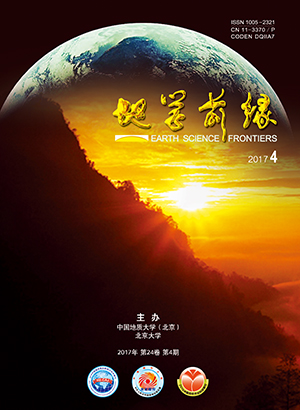|
|
Geological characteristics and ore minerals of the Taldybulak Levoberezhny gold deposit, Kyrgyzstan.
XI Wei,XIA Xiaohong,WU Yanshuang,YE Tian,LI Nuo
2018, 25(5):
135-150.
DOI: 10.13745/j.esf.sf.2018.4.9
The Taldybulak Levoberezhny deposit (130 t@6.9 g/t) is the third largest gold deposit in northern Tienshan, Kyrgyz. Since its discovery in 1963, no detailed mineralogical studies has been done, especially on ore minerals in the deposit. The ore genesis is still under debate over the proposed origins including porphyry, orogenic or multi-stage overprint. In this contribution, through detailed field survey and petrographic observation, we discovered that gold mineralization was mainly controlled by both shear zones and later intrusion with ore bodies parallel to the strata. The ores can be divided into at least five types according to texture and composition: dissemination-stockwork (hosted in intrusions such as monzogranite), quartz-tourmaline-sulfide, massive ores, dissemination (hosted in altered metamorphic rocks) and calcite-sulfide vein types. Related hydrothermal alterations are dominated by silicic, sericite, tourmaline and calcite alterations with minor chlorite and epidote alterations or argillation. Electron microprobe analysis (EMPA) revealed both visible and invisible gold in the ores. The visible gold includes electrum (Au: 67.90%80.86%; Ag: 14.24%30.76%) and silver-bearing native gold (Au: 88.95%; Ag: 8.09%), and occur as micro-mineral inclusions enclosed in pyrite or distributed along pyrite boundaries or fractures, while the invisible gold resides in pyrite or chalcopyrite containing 0.16%0.33% Au. Pyrite from different types of ores display variable morphology, texture and composition. In the dissemination-stockwork ores hosted in monzogranite, pyrite generally occurs as medium-coarse sized (301300 μm, mostly >200 μm) subhedral to euhedral cubic grains; it may contain native gold, electrum or silicate inclusions, with little or no cracks; commonly, moderate amounts of As (0.03%1.72%, averaging 0.66%), Co (0.06%0.19%, averaging 0.13%) and Te (0.03%0.06%, averaging 0.04%), with moderate As/S, Fe/S and Co/As ratios and limited Cu, Pb, Zn and Ag are present. In the quartz-tourmaline-sulfide ores, the medium-coarse sized (302000 μm) subhedral to anhedral pyrite are often fractured and replaced by minerals such as chalcopyrite or galena; some grains may also contain electrum or silicate as inclusions; and it is generally embedded with high concentrations of As (0.05%2.05%, averaging 0.97%) and Co (0.05%0.34%, averaging 0.15%), and has high As/S and Fe/S but low Co/As ratios. In the massive ores, pyrite also has the subhedral to anhedral texture, although grain sizes vary greatly from 30300 μm to 2503300 μm; the pyrite composition is characterized by high contents of As (0.05%2.20%, averaging 1.21%) and Te (0.04%0.09%, averaging 0.06%), high ratios of As/S and Fe/S, but low ratio of Co/As. In the disseminated ores hosted by altered metamorphic rocks, pyrite grains are medium sized (mainly 50200 μm) with subhedral to anhedral texture, and contain some inclusions (e.g. sulfide, silicate, native gold or electrum) or fractures; their compositions vary greatly, although as a whole the Co content (0.08%1.04%, averaging 0.35%) and Co/As ratio are high, but no Te, Cu and Zn. In calcitesulfide veins, pyrite occurs as medium-coarse sized (40480 μm) subhedralanhedral grains, and may contain silicate inclusions; it is typified by ultra low As (0.04%0.08%, averaging 0.06%) and Co (0.04%0.20%, average 0.10%) contents and As/S and Fe/S ratios, but high Co/As ratio; it does not contain any detectable Zn. Based on pyrite ore-controlling structures, mineralization types, wallrock alterations, and variable structural chemical features, we propose that the Taldybulak Levoberezhny gold deposit may be formed by multi-stage superimposed mineralization.
Related Articles |
Metrics
|

